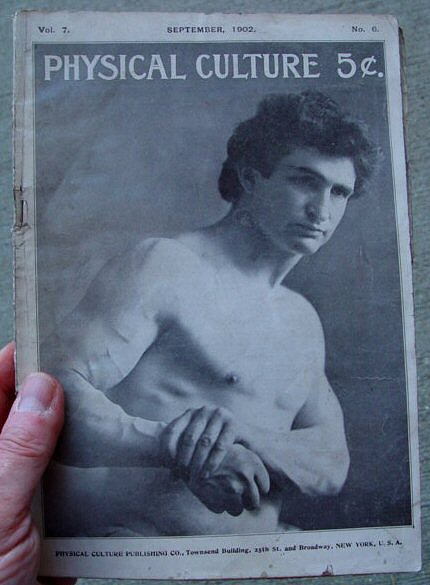 An
early issue from September, 1902 showing Macfadden on the cover. It was
during this time that the magazine became a success with about 100,000
readers and still growing. This is one of the older issues in my collection. An
early issue from September, 1902 showing Macfadden on the cover. It was
during this time that the magazine became a success with about 100,000
readers and still growing. This is one of the older issues in my collection.
His famous slogan, "Weakness
is a Crime - Don't be a Criminal," appeared on many of the covers but does
not on this particular issue.
The format is 6½ x
9½ inches and is 68 pages (including the cover) in length. At this
time, pages in the front and back which were exclusively advertisements
were not numbered. The pages with articles were numbered but not by the
individual issue but by the volume. In this issue the article page numbers
range from 311 - 352. |
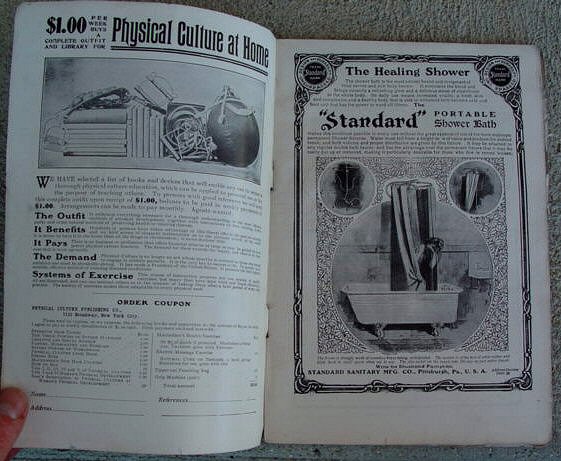 Inside
the front cover are advertisements for Macfadden's exercise equipment and
a portable shower. At this time, very few if any well known companies advertised
their products in his magazine. The advertisements featured body building
equipment, courses in self improvement, natural foods, and a lot of Macfadden's
books. The earliest issues of Physical Culture were mainly pamphlets
designed to sell exercise equipment and books. This issue had not quite
broken away from that purpose. Inside
the front cover are advertisements for Macfadden's exercise equipment and
a portable shower. At this time, very few if any well known companies advertised
their products in his magazine. The advertisements featured body building
equipment, courses in self improvement, natural foods, and a lot of Macfadden's
books. The earliest issues of Physical Culture were mainly pamphlets
designed to sell exercise equipment and books. This issue had not quite
broken away from that purpose.
The advertisement on the
left offered Macfadden's original exercise apparatus, a punching bag, a
device for strengthening the grip, a back massager, 16 books, and a year's
subscription to Physical Culture for just $1 per week for 23 weeks. |
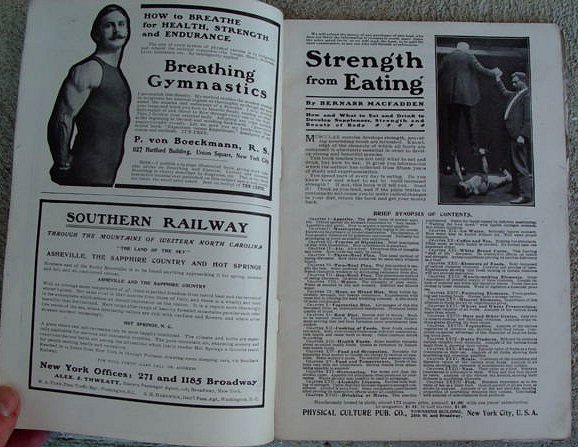 The
next two pages - more advertisements. The page on the right is interesting
because it promotes Macfadden's book, Strength from Eating, with
a complete synopsis of the contents. The cost was $1. The
next two pages - more advertisements. The page on the right is interesting
because it promotes Macfadden's book, Strength from Eating, with
a complete synopsis of the contents. The cost was $1.
The photograph is interesting.
It is a photo of Macfadden who has just completed a 7 day fast, lying on
his back and lifting a large man using the muscles of his arms only. |
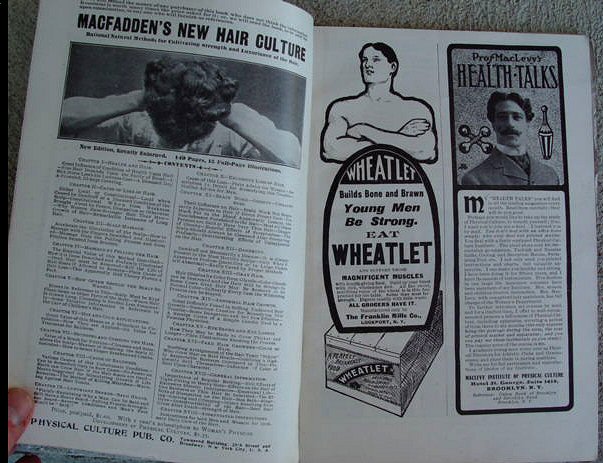 A
full page ad for Macfadden's book on how to have a full head of healthy
hair. Again, the text of the ad is merely a chapter-by-chapter synopsis
of the contents of the book. A
full page ad for Macfadden's book on how to have a full head of healthy
hair. Again, the text of the ad is merely a chapter-by-chapter synopsis
of the contents of the book.
Two ads on the right: one
is for a breakfast cereal named Wheatlet, and the other is for health lectures
and a mail order course by a mustachioed individual in a stiff high collar
named Professor MacLevy. |
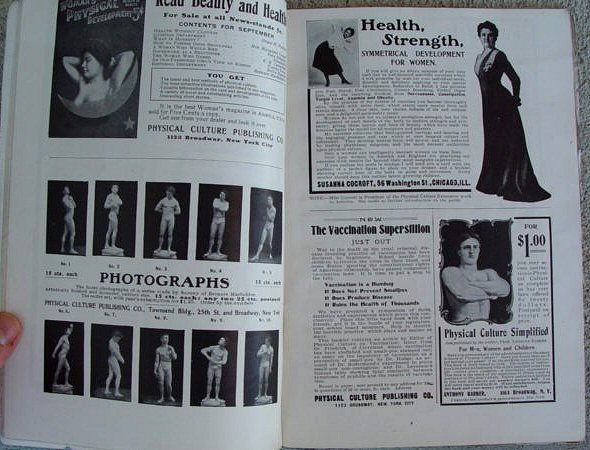 Upper
left is an ad for Macfadden's Woman's Physical Development, also
titled Beauty and Health, a magazine for women. Upper
left is an ad for Macfadden's Woman's Physical Development, also
titled Beauty and Health, a magazine for women.
Lower left is a series of
10 photographs of Macfadden in a variety of classical poses - 15¢
each.
On the right side are 2 ads
for exercise programs - one for women, one for men - and a pamphlet by
Macfadden condemning vaccination as a "cruel, criminal, disease breeding
practice." |
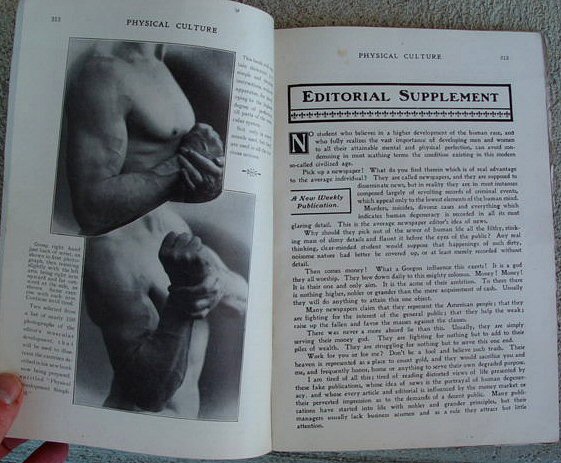 Photos
illustrating resistance exercises for building the muscles of the arms
and an editorial article by Bernarr Macfadden on how almost all news publications
are geared toward only one thing -making money, and they do not report
the news accurately. Instead, they focus on "human degeneracy." The newspapers
are "composed largely of revolting records of criminal events, which appeal
only to the lowest elements of the human mind." He goes on to ask people
who believe in the "higher elevation of humanity" to lend their support
for (meaning buy) a weekly newspaper which "will be called --- 'THE CRY
FOR JUSTICE.'" The idea was to publish a newspaper that would report good,
uplifting, wholesome news. It actually ran for about a year and promoted an ultra-left
point of view that bordered on socialism (totally out of character with Macfadden's other publications). Photos
illustrating resistance exercises for building the muscles of the arms
and an editorial article by Bernarr Macfadden on how almost all news publications
are geared toward only one thing -making money, and they do not report
the news accurately. Instead, they focus on "human degeneracy." The newspapers
are "composed largely of revolting records of criminal events, which appeal
only to the lowest elements of the human mind." He goes on to ask people
who believe in the "higher elevation of humanity" to lend their support
for (meaning buy) a weekly newspaper which "will be called --- 'THE CRY
FOR JUSTICE.'" The idea was to publish a newspaper that would report good,
uplifting, wholesome news. It actually ran for about a year and promoted an ultra-left
point of view that bordered on socialism (totally out of character with Macfadden's other publications). |
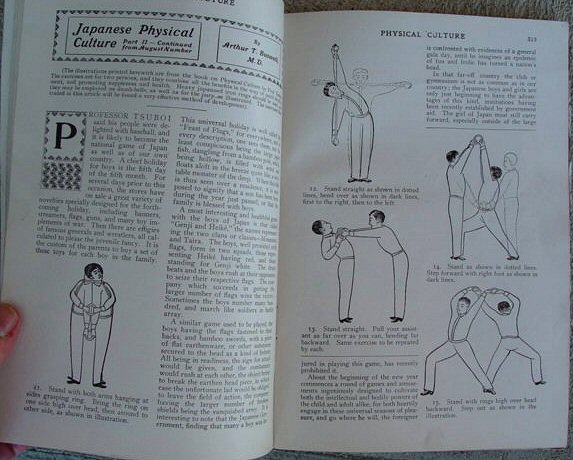 The
magazine offered a wealth of information on different kinds of exercise.
Here is part 2 of an article on a form of Japanese exercise. The
magazine offered a wealth of information on different kinds of exercise.
Here is part 2 of an article on a form of Japanese exercise. |
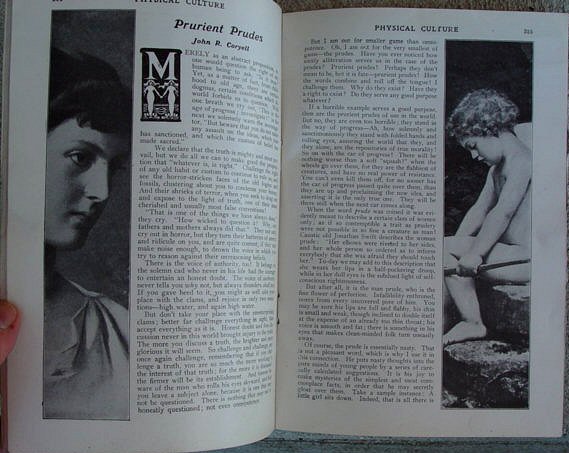 An
article by John Coryell which tells the reader how "prurient prudes" have
hindered the march of progress toward an educated populace that sees sex
as something that is healthy and good. An
article by John Coryell which tells the reader how "prurient prudes" have
hindered the march of progress toward an educated populace that sees sex
as something that is healthy and good.
The pictures that accompany
this article are typical examples of how Macfadden used reproductions from
classical art to show an idealized human form and to celebrate the beauty
of the human body. |
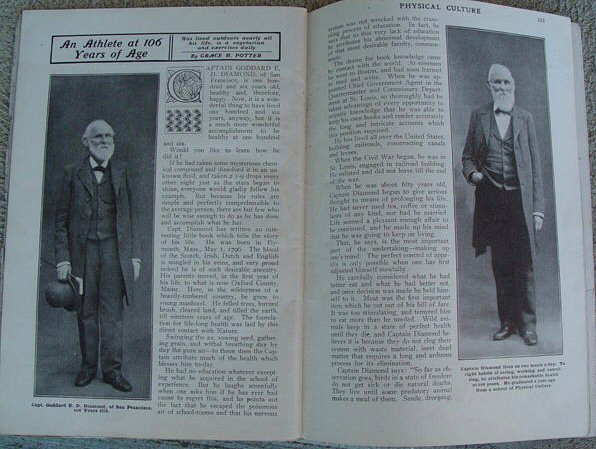 Physical
Culture had regular articles on the subject of defeating old age and
staying healthy and physically fit. This is an article about a man who
"is one hundred and six years old, healthy and, therefore, happy." Physical
Culture had regular articles on the subject of defeating old age and
staying healthy and physically fit. This is an article about a man who
"is one hundred and six years old, healthy and, therefore, happy." |
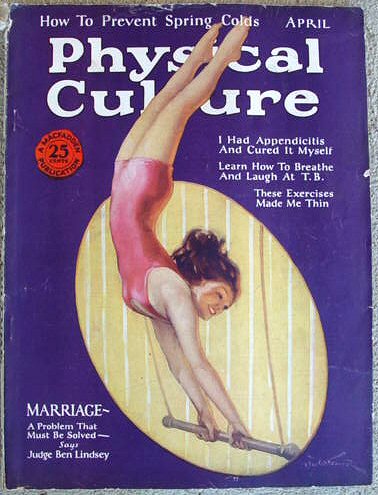 I
have selected this issue from April, 1925 to illustrate the magazine during
the height of its success. This issue has 156 pages, including the cover.
The format is now a full 8½ x 11½ inches. The full color
cover illustration is both spectacular and very typical - a young, scantily
clad, athletic woman portrayed in a dynamic and sensual manner. There is
a lot of movement in this illustration. The cover artist was Jay Weaver. I
have selected this issue from April, 1925 to illustrate the magazine during
the height of its success. This issue has 156 pages, including the cover.
The format is now a full 8½ x 11½ inches. The full color
cover illustration is both spectacular and very typical - a young, scantily
clad, athletic woman portrayed in a dynamic and sensual manner. There is
a lot of movement in this illustration. The cover artist was Jay Weaver.
Part of the formula which
Macfadden developed for selling magazines was to put short statements on
the covers to entice people to buy the magazines to read the articles.
Macfadden hired writers and editors who were experts at this kind of writing.
The price of the magazine
was 25 cents - not cheap for its day. |
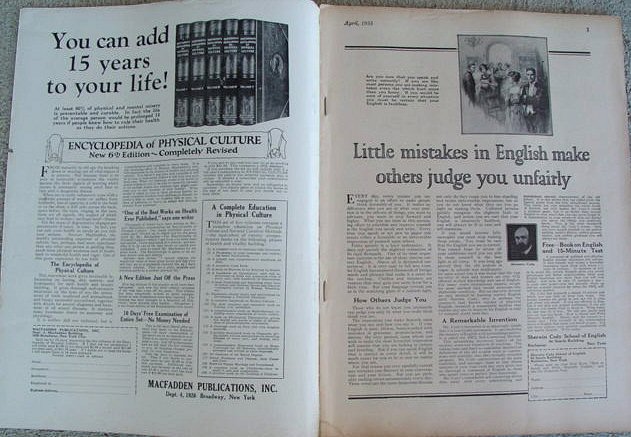 Inside
the front cover is an advertisement for his 5 volume set of encyclopedias.
The advertisement no longer relied on just giving a synopsis of the content.
Instead, it touted all the benefits a person would derive from owning the
set - "You can add 15 years to your life!" Inside
the front cover is an advertisement for his 5 volume set of encyclopedias.
The advertisement no longer relied on just giving a synopsis of the content.
Instead, it touted all the benefits a person would derive from owning the
set - "You can add 15 years to your life!"
The advertisement on the
right side is for a course which is supposed to teach the student how to
speak and write correct English - a valuable asset which will enhance a
person's popularity and job potential. This kind of self improvement advertisement
is very typical. |
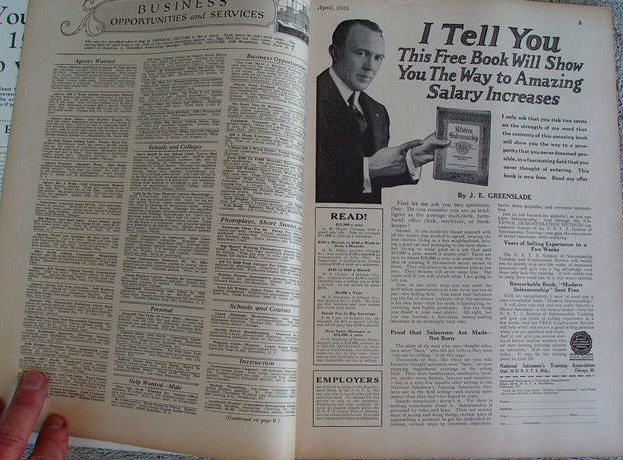 Another
ad for a self improvement course and a listing of business opportunities
and services (paid advertisers). Another
ad for a self improvement course and a listing of business opportunities
and services (paid advertisers). |
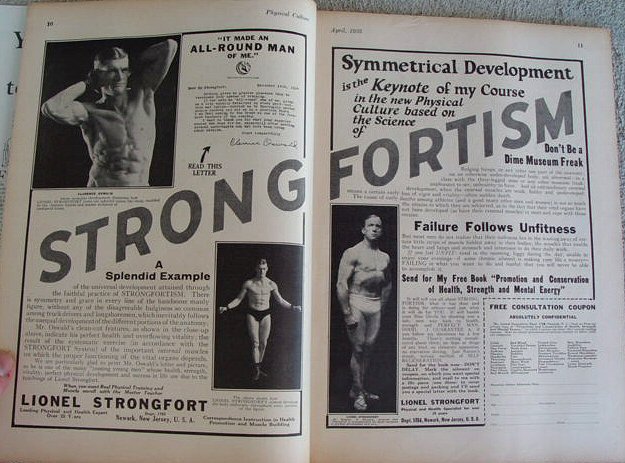 A
classic body building ad by Lionel Strongfort. A
classic body building ad by Lionel Strongfort. |
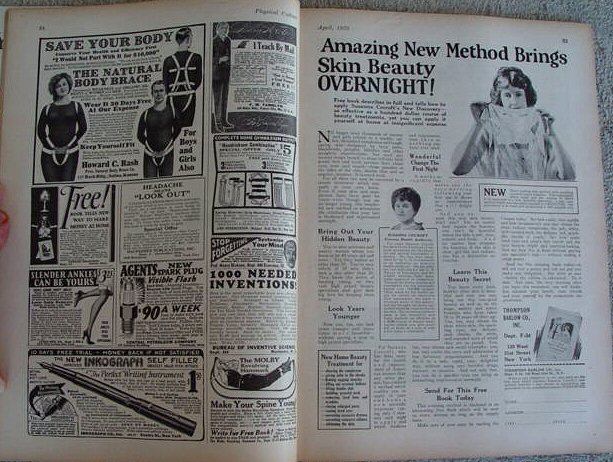 Another
sampling of the kinds of ads in Physical Culture. There were still
many of the same kinds of advertisers as seen in earlier issues, but the
kinds of businesses advertising in Physical Culture at this time
were increasing. Another
sampling of the kinds of ads in Physical Culture. There were still
many of the same kinds of advertisers as seen in earlier issues, but the
kinds of businesses advertising in Physical Culture at this time
were increasing. |
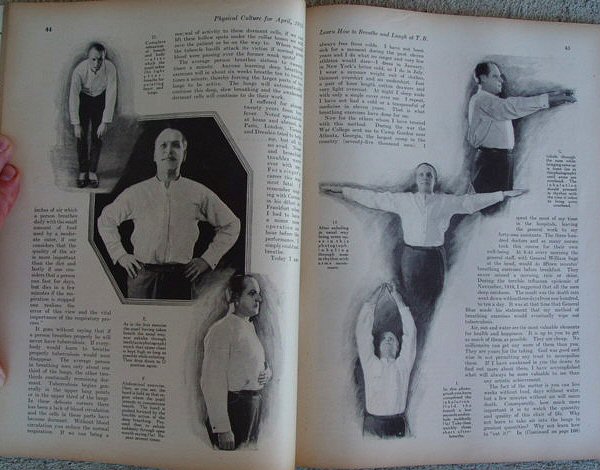 There
were always instructions on exercise. Macfadden liked to show celebrities
exercising, and here we have a well known opera singer demonstrating his
exercise routine. There
were always instructions on exercise. Macfadden liked to show celebrities
exercising, and here we have a well known opera singer demonstrating his
exercise routine.
Notice the beautiful layout
design of photos and text on these pages. |
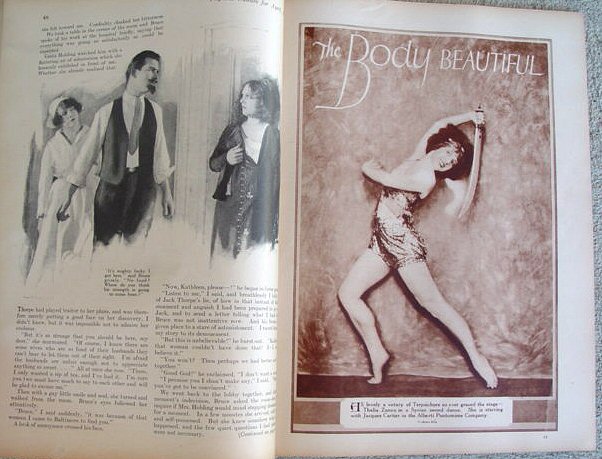 "The
Body Beautiful" became a regular feature. This section was often printed
in sepia tones to set it off from the rest of the magazine. Macfadden had
a staff of highly skilled photographers. The photography was spectacular. "The
Body Beautiful" became a regular feature. This section was often printed
in sepia tones to set it off from the rest of the magazine. Macfadden had
a staff of highly skilled photographers. The photography was spectacular. |
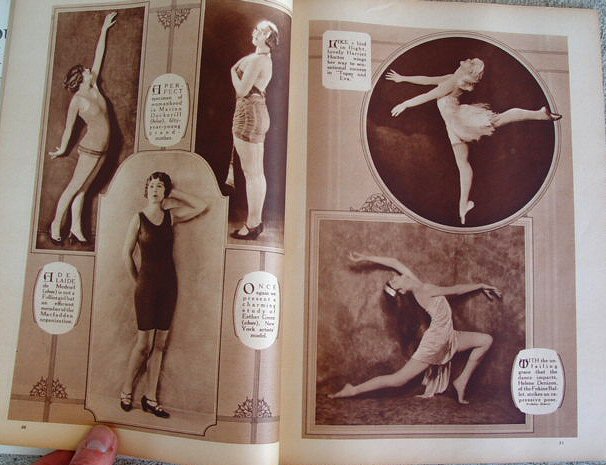 "The
Body Beautiful" continued. The people featured in this section were sometimes
celebrities, professional dancers or models, but most often they were amateur
physical culturists. "The
Body Beautiful" continued. The people featured in this section were sometimes
celebrities, professional dancers or models, but most often they were amateur
physical culturists. |
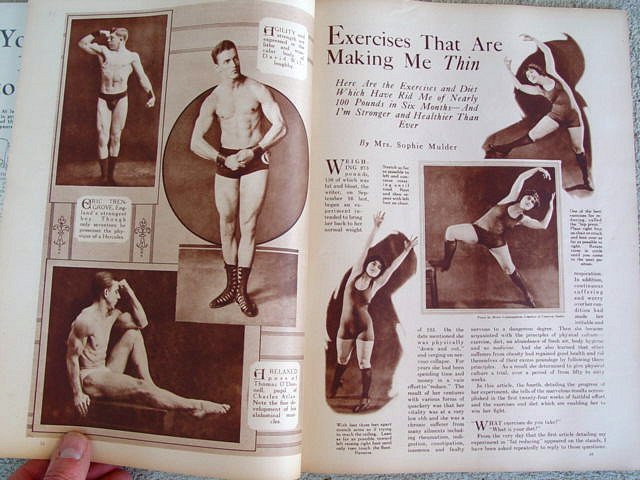 On
the left is the last page of the "Body Beautiful" section. Male physiques
were always on display within the pages of the magazine. On the right is
an article on exercises for women. On
the left is the last page of the "Body Beautiful" section. Male physiques
were always on display within the pages of the magazine. On the right is
an article on exercises for women. |
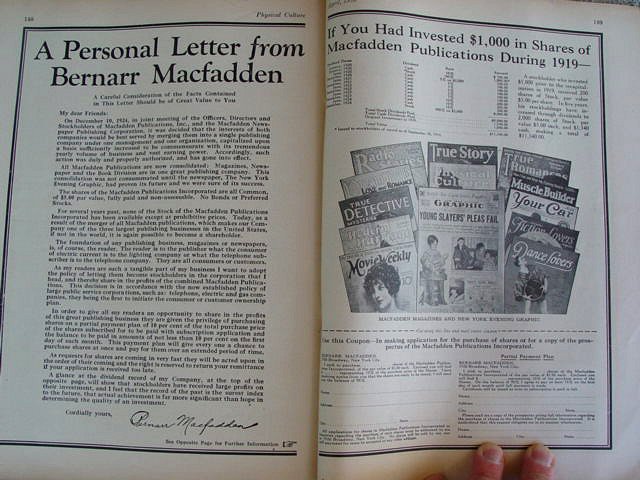 An
interesting 2 page advertisement in which Macfadden encourages his readers
to invest in stock in Macfadden Publications. Twelve of his magazines and
the NY Evening Graphic newspaper are shown here. An
interesting 2 page advertisement in which Macfadden encourages his readers
to invest in stock in Macfadden Publications. Twelve of his magazines and
the NY Evening Graphic newspaper are shown here. |
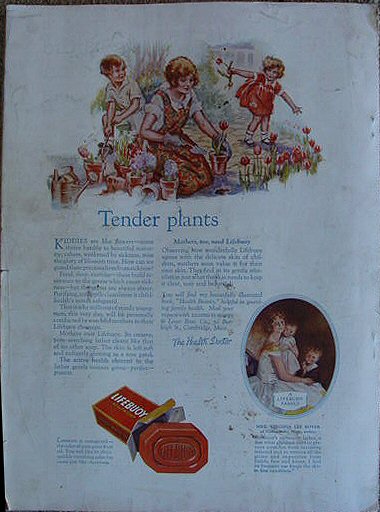 The
advertisement on the back cover - Lifebuoy Soap. Well known and highly
respected businesses were now advertising in Physical Culture. The
advertisement on the back cover - Lifebuoy Soap. Well known and highly
respected businesses were now advertising in Physical Culture. |
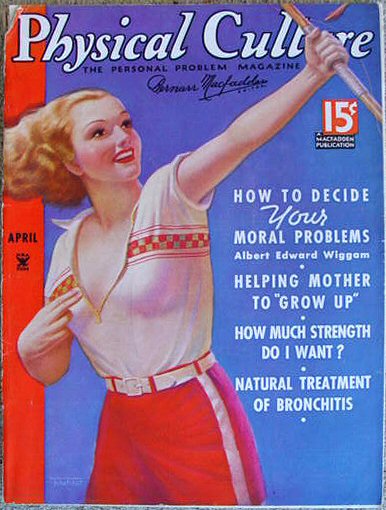 April,
1935. The cover art is by Victor Tchetchet and is a beautiful example.
By this time the popularity of Physical Culture Magazine had begun to decline.
The number of pages has dropped down to 106. Notice that the price has
been cut to 15 cents. April,
1935. The cover art is by Victor Tchetchet and is a beautiful example.
By this time the popularity of Physical Culture Magazine had begun to decline.
The number of pages has dropped down to 106. Notice that the price has
been cut to 15 cents. |
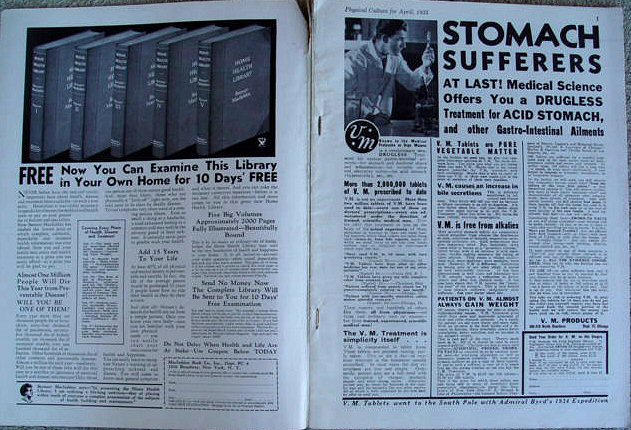 Advertisements
inside the front cover. Advertisements
inside the front cover. |
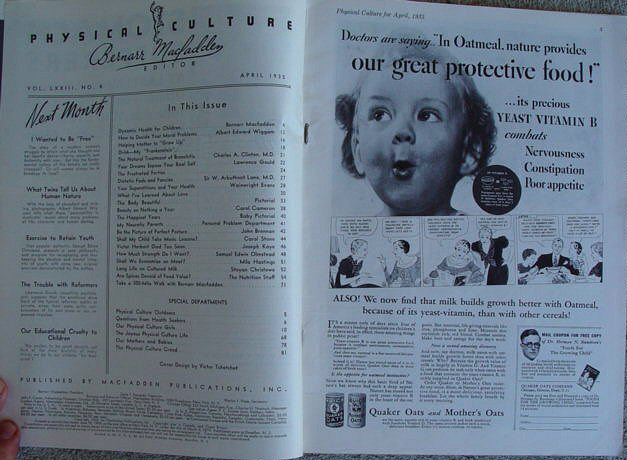 The
table of contents and an ad for Quaker Oats. More mainstream companies
are advertising but the magazine as a whole has lost its "cutting edge"
and become much tamer. In fact, it looks just like a whole lot of other
magazines. There was a lot more focus on families, children and mothers.
There were very few articles on actual body building. The
table of contents and an ad for Quaker Oats. More mainstream companies
are advertising but the magazine as a whole has lost its "cutting edge"
and become much tamer. In fact, it looks just like a whole lot of other
magazines. There was a lot more focus on families, children and mothers.
There were very few articles on actual body building. |
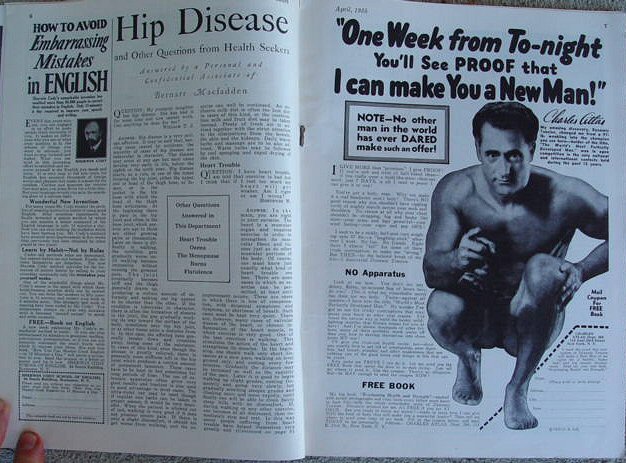 This
Charles Atlas ad is interesting. Notice that articles are now interspersed
with advertisements. This
Charles Atlas ad is interesting. Notice that articles are now interspersed
with advertisements. |
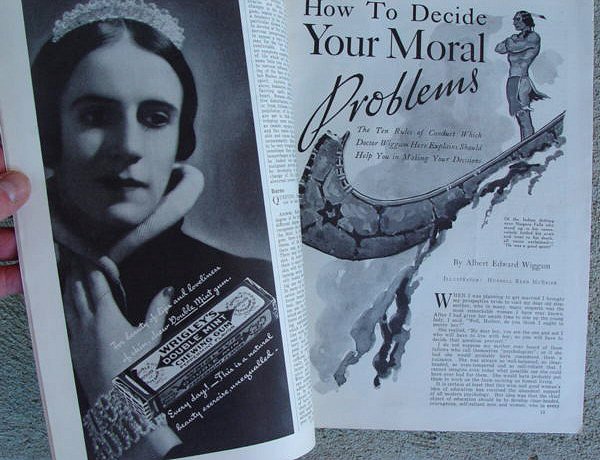 Wrigley's
gum ad and an article on morality. The design of the illustration and text
is masterful. However, the article is rather dull and stuffy. It is aimed
at a general audience (nothing offensive) and lacks the outspoken quality
of articles in earlier issues. Wrigley's
gum ad and an article on morality. The design of the illustration and text
is masterful. However, the article is rather dull and stuffy. It is aimed
at a general audience (nothing offensive) and lacks the outspoken quality
of articles in earlier issues. |
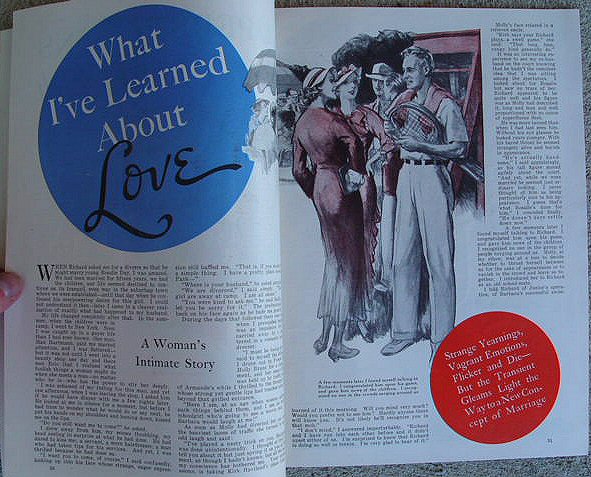 A
True
Story type of love and romance article. A
True
Story type of love and romance article. |
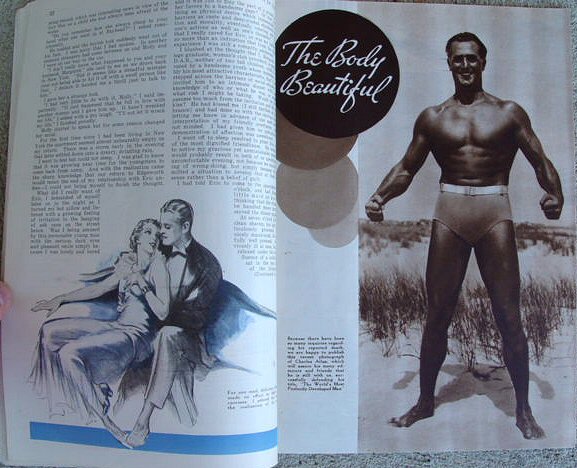 Charles
Atlas appears in "The Body Beautiful" section. Charles
Atlas appears in "The Body Beautiful" section. |
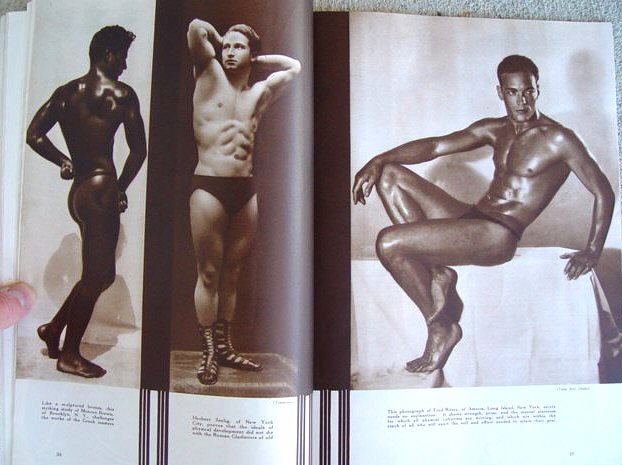 "The
Body Beautiful" continued - beefcake. These were amateur body builders. "The
Body Beautiful" continued - beefcake. These were amateur body builders. |
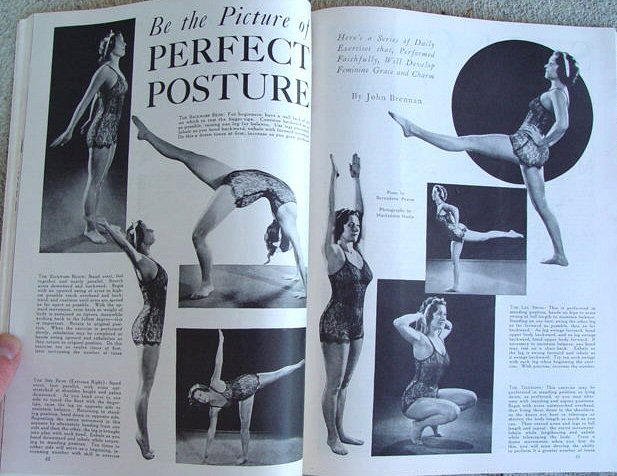 Exercises
for women - to "develop feminine grace and charm." This represents a real shift
in emphasis from strength and fitness to poise and beauty. Exercises
for women - to "develop feminine grace and charm." This represents a real shift
in emphasis from strength and fitness to poise and beauty. |
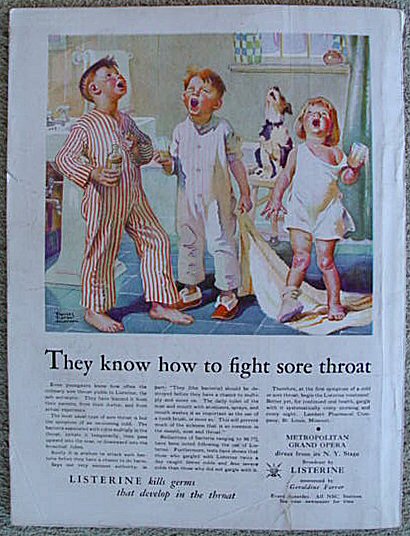 Listerine
advertised on the back cover. The magazine had unfortunately lost its unique
identity. Listerine
advertised on the back cover. The magazine had unfortunately lost its unique
identity. |
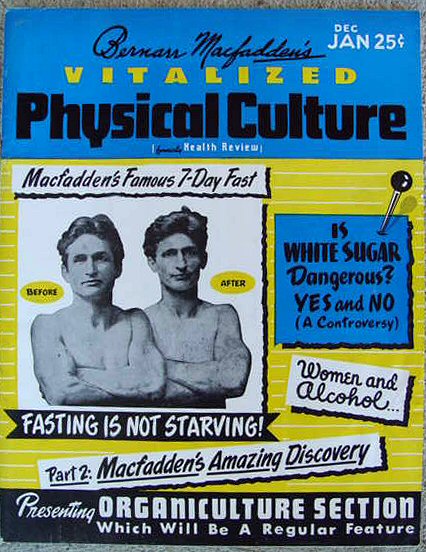 December
1951 - January 1952. This was one of the last issues and was the final
newsstand issue. It contained only 52 pages. After that, the magazine was
by subscription only. When the subscriptions ended, the longest running
fitness magazine in history ceased publication for good. December
1951 - January 1952. This was one of the last issues and was the final
newsstand issue. It contained only 52 pages. After that, the magazine was
by subscription only. When the subscriptions ended, the longest running
fitness magazine in history ceased publication for good.
Macfadden had tried everything
he possibly could to make the magazine a success again -even changing the
name to Macfadden's Health Review and then changing it back to Physical
Culture, albeit "Vitalized." At one point, he had actually built the
readership back up to about 100,000, but it could not be sustained.
The photo on the cover is
of Macfadden many years earlier documenting his famous 7 day fast. There
is a tiny article inside titled "Fasting Is Not Starving." It fills barely
a quarter of a page. |
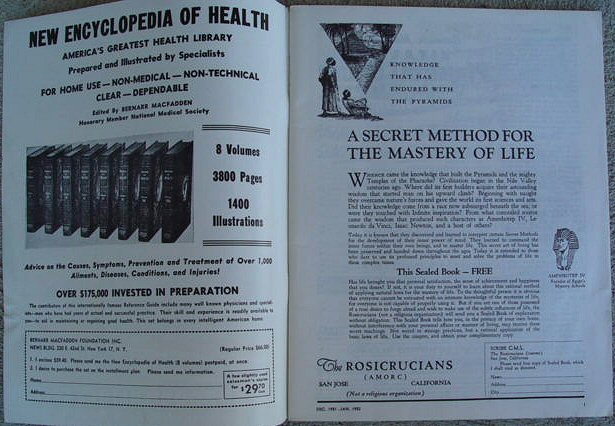 An
advertisement for his encyclopedia and the Rosicrucians. Notice all the
empty white space. The layout is plain and unappealing. An
advertisement for his encyclopedia and the Rosicrucians. Notice all the
empty white space. The layout is plain and unappealing. |
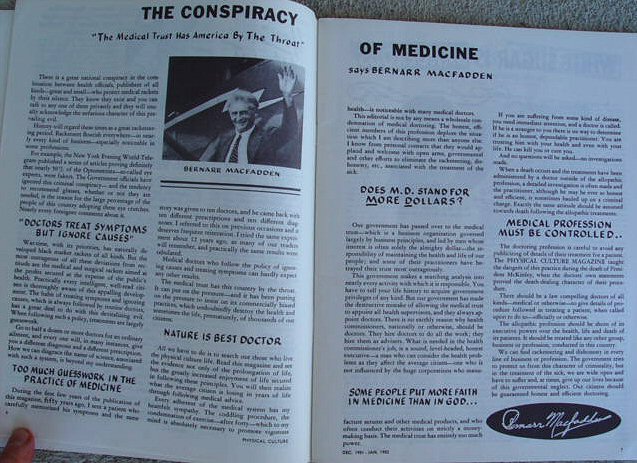 An
article by Macfadden which does show some of the old "fire." It condemns
the medical "trust." An
article by Macfadden which does show some of the old "fire." It condemns
the medical "trust." |
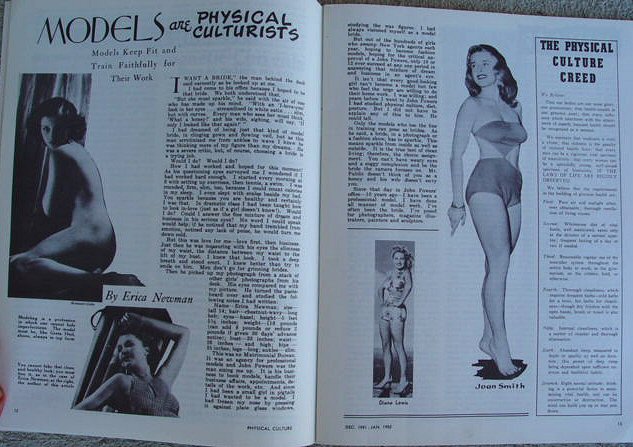 Macfadden
always had an eye for the ladies. This is the story of a model, how she
succeeded and how important physical fitness is to her career. Macfadden
always had an eye for the ladies. This is the story of a model, how she
succeeded and how important physical fitness is to her career. |
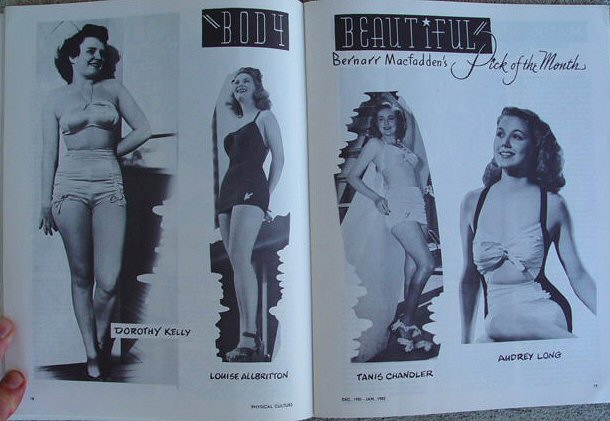 "The
Body Beautiful" section looks more like a school yearbook than a professionally
designed publication. "The
Body Beautiful" section looks more like a school yearbook than a professionally
designed publication. |
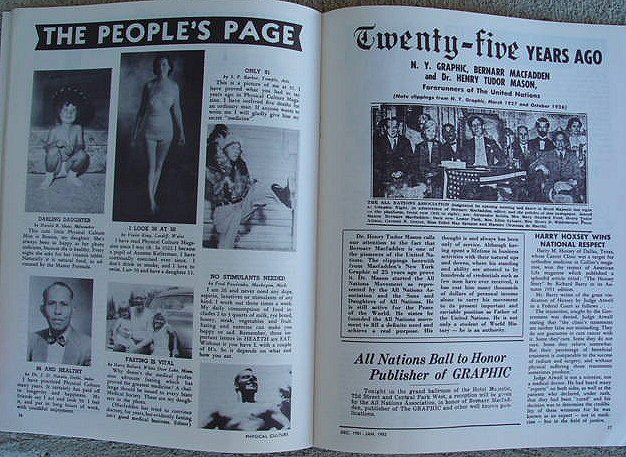 Pictures
of amateurs and an article about past glories. Pictures
of amateurs and an article about past glories. |
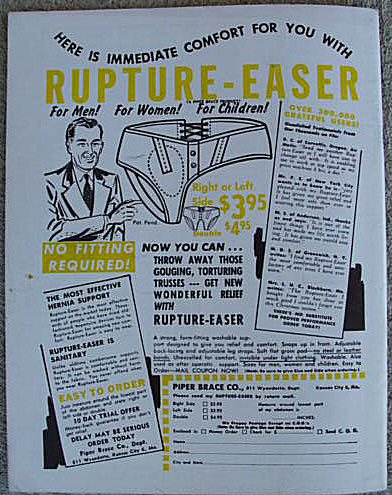 The
back cover - the Rupture Easer has replaced Lifebuoy and Listerine. The
back cover - the Rupture Easer has replaced Lifebuoy and Listerine. |
|
CLOSE THIS WINDOW TO RETURN
|